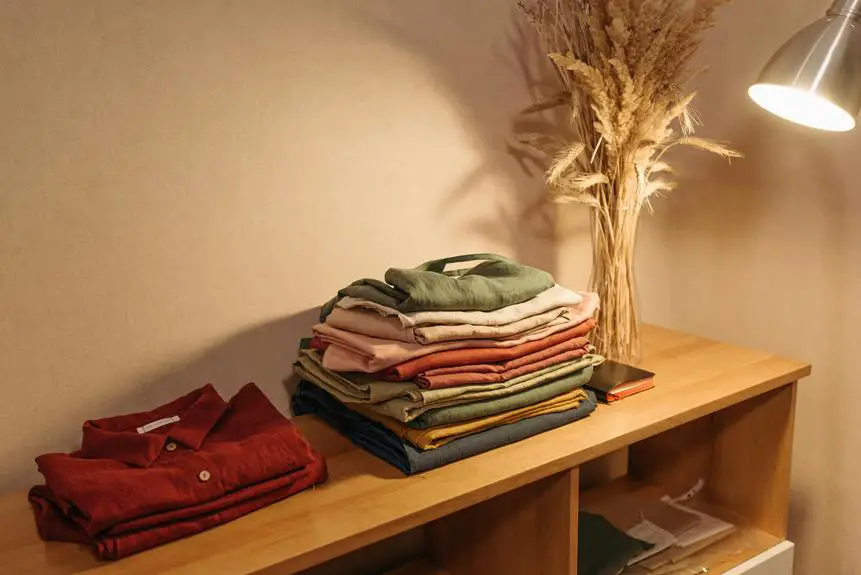When you're choosing fabrics, it's essential to consider how they'll hold up against creasing. You might find that synthetic options like polyester and nylon offer remarkable durability and wrinkle resistance, perfect for your busy lifestyle. But don't overlook blends or even natural fibers—each has unique properties that can enhance your wardrobe's longevity. Curious about which fabric types truly stand out in wrinkle prevention? There's more to explore that could change how you approach your clothing choices.
Table of Contents
Key Takeaways
- Polyester is highly durable and naturally wrinkle-resistant, making it ideal for everyday wear without frequent ironing.
- Nylon offers lightweight and stretchy qualities, perfect for activewear and travel, reducing the likelihood of creasing.
- Spandex enhances shape retention in garments, helping them maintain a smooth appearance and resist creasing.
- Tencel is soft and breathable, with natural properties that reduce creasing, ensuring a polished look throughout the day.
Understanding Fabric Weaves
When you understand different fabric weaves, you'll see how they impact a material's ability to resist creasing. The weave of a fabric determines its structure, which influences how it drapes and how wrinkles form.
For instance, a plain weave, characterized by its simple over-and-under pattern, tends to be more prone to creasing. While it's versatile and widely used, it doesn't provide much resistance to wrinkles.
On the other hand, twill weaves, with their diagonal pattern, offer better durability and less tendency to crease. This is because the interlacing of threads creates a more resilient fabric. Similarly, satin weaves, known for their smooth surface and luxurious feel, can also resist creasing well due to their tightly packed threads.
Understanding these weaves can help you make informed decisions when selecting fabrics for clothing or home textiles. If you prioritize a polished look with minimal maintenance, opting for fabrics with tighter weaves or those that incorporate specialized finishes can be beneficial.
Synthetic Fabrics Overview
Synthetic fabrics, made from chemically processed fibers, are often designed to resist creasing and maintain a polished appearance with minimal effort. These materials are popular in the fashion industry for their durability and low maintenance needs, making them ideal for busy lifestyles.
You'll find that synthetic fabrics come in various types, each with unique properties.
Here are some key benefits of synthetic fabrics:
- Wrinkle Resistance: They're engineered to resist wrinkles, so you won't need to iron them often.
- Durability: Synthetic fibers are typically more durable than natural fibers, ensuring your garments last longer.
- Stain Resistance: Many synthetic fabrics are treated to repel stains, making them easier to clean.
- Quick Drying: They dry faster than traditional fabrics, which is perfect for active wear or travel.
Incorporating synthetic fabrics into your clothing choices can help you maintain a stylish look without the hassle of constant upkeep.
Natural Fibers That Resist Wrinkles
When it comes to natural fibers that resist wrinkles, you'll find that cotton, linen, and wool each offer unique benefits.
Cotton is breathable, keeping you comfortable while minimizing creasing.
Linen boasts a natural resilience, and wool's elastic properties help it retain its shape, making these fabrics great options for wrinkle-resistant clothing.
Cotton's Breathability Advantage
Cotton stands out for its breathability, allowing air to circulate and helping you stay comfortable while naturally resisting wrinkles. This makes cotton an excellent choice for those who want to look sharp without sacrificing comfort. Its ability to wick moisture away from your skin keeps you cool, making it perfect for warm weather or active days.
When choosing cotton, consider the following advantages:
- Natural Fiber: Cotton is a plant-based material, making it a sustainable option.
- Softness: It's gentle on your skin, providing all-day comfort.
- Versatility: Cotton fabrics come in various weaves and weights, suitable for any occasion.
- Easy Care: Most cotton items are machine washable and can be tumble dried, ensuring convenience.
Incorporating cotton into your wardrobe not only helps you avoid creasing but also enhances your overall comfort.
Linen's Natural Resilience
Linen offers a unique combination of breathability and natural resilience, making it another excellent fabric choice for those looking to minimize creasing. Its fibers are inherently strong and have a natural stiffness, which helps maintain the fabric's structure even after wear. This means you can enjoy a fresh, crisp look without worrying about constant ironing.
When you choose linen, you'll benefit from its moisture-wicking properties, keeping you cool and comfortable in warm weather. Unlike other fabrics that easily cling and crease, linen's texture allows air to flow freely, reducing the chances of unsightly wrinkles. Plus, as you wear linen, it develops a natural patina, adding character to your outfit without compromising style.
Another advantage of linen is that it actually becomes softer with each wash, enhancing its comfort while still resisting creasing. So, if you're looking for a fabric that marries style with practicality, linen is a solid option.
Try incorporating linen pieces into your wardrobe, and you'll appreciate how effortlessly chic and low-maintenance they can be, allowing you to focus on enjoying your day rather than worrying about your appearance.
Wool's Elastic Properties
Wool's unique elastic properties make it a fantastic choice for those seeking fabrics that resist wrinkles and maintain their shape throughout the day. Unlike many other natural fibers, wool can stretch and recover its original form, thanks to its unique protein structure. This elasticity not only helps prevent creasing but also contributes to a comfortable fit.
When you choose wool, you're opting for a versatile fabric that offers several benefits:
- Wrinkle resistance: Wool's natural crimp retains its shape, reducing the likelihood of creases.
- Moisture-wicking: It absorbs moisture without feeling wet, keeping you comfortable and fresh.
- Temperature regulation: Wool keeps you warm in the winter and cool in the summer, adapting to your body temperature.
- Durability: It resists wear and tear, making it a long-lasting investment for your wardrobe.
Blends for Enhanced Durability
When choosing fabrics, blends like polyester-cotton offer enhanced durability while minimizing creasing. These blends combine the best qualities of each fiber, making them resistant to wear and tear. Polyester adds strength, while cotton provides breathability and comfort. This combination ensures that your clothing can withstand daily use without losing its shape or becoming overly wrinkled.
Another popular blend is rayon-linen. This mix provides a soft, luxurious feel while maintaining durability. Linen is known for its natural strength, and when paired with rayon, it creates a fabric that's both stylish and practical. You'll appreciate how well it holds up over time, even with regular washing.
Don't overlook Tencel blends either. Tencel, derived from sustainable wood sources, offers excellent moisture-wicking properties and is less prone to creasing than pure cotton. Blending Tencel with other fibers results in a fabric that feels great against your skin and looks polished.
Choosing the right blend can significantly impact your wardrobe's longevity and appearance. By opting for these durable blends, you'll find you spend less time worrying about wrinkles and more time enjoying your stylish, hassle-free attire.
Care Tips for Wrinkle-Free Fabrics
To keep your wrinkle-free fabrics looking their best, follow these simple care tips that can help maintain their smooth appearance. With a little effort, you can ensure your garments stay sharp and fresh, ready for any occasion.
Wash in cold water: Hot water can cause fabrics to lose their shape and smoothness. Stick to a cold wash to preserve their integrity.
Avoid overloading the dryer: Give your clothes enough space to tumble freely. Overloading can create wrinkles, even in wrinkle-resistant fabrics.
Remove promptly: As soon as your dryer cycle ends, take your clothes out. Leaving them in can lead to creases setting in.
Hang or lay flat to dry: Instead of tossing them in the dryer, hang or lay your garments flat to dry. This helps maintain their shape and smoothness.
Store properly: Use padded hangers for delicate items and fold heavier fabrics to avoid unnecessary creasing.
Choosing the Right Garment
When you're picking a garment, fabric composition plays a crucial role in how much it creases.
You also need to consider the style and fit, as these factors can significantly affect wrinkle resistance.
Choosing wisely can keep you looking sharp all day long.
Fabric Composition Matters
Choosing the right fabric composition is essential for minimizing creasing and keeping your garments looking fresh throughout the day.
When you're selecting clothes, consider materials that resist wrinkles and maintain their shape. Here are some fabric options that can help you stay crease-free:
- Polyester: This synthetic fiber is known for its durability and resistance to wrinkles, making it a popular choice for everyday wear.
- Nylon: Lightweight and stretchy, nylon doesn't easily crease, making it great for activewear and travel garments.
- Spandex: Often blended with other fabrics, spandex provides stretch and helps garments retain their shape, reducing the likelihood of creasing.
- Wool: Natural wool fibers have good elasticity, allowing them to bounce back into shape after being wrinkled.
Style and Fit Considerations
The right style and fit can significantly reduce creasing, ensuring your clothes look polished and presentable all day long. When choosing garments, consider the cut and design. Loose-fitting clothes tend to allow more air circulation, which can help minimize wrinkles. Avoid overly tight styles, as they can create stress on the fabric, leading to creases.
Opt for structured pieces, like tailored blazers or fitted dresses, which often hold their shape better than softer, slouchy options. Look for items with minimal seams and darts, as these features can contribute to creasing. Additionally, garments with a bit of stretch can offer more comfort and resilience, reducing the chance of wrinkling.
Pay attention to the length of your clothes, too. Longer garments, such as maxi dresses or wide-leg pants, can drape more naturally, which may help prevent creases from forming.
Frequently Asked Questions
What Are the Best Fabrics for Travel to Prevent Creasing?
When you're traveling, look for fabrics like polyester, nylon, or spandex blends. These materials resist wrinkling and keep your outfits looking fresh. You'll appreciate how easy they are to pack and maintain during your trips.
How Do I Store Wrinkle-Resistant Clothes Properly?
To store wrinkle-resistant clothes properly, hang them in a cool, dry place. Use padded hangers to maintain shape, and avoid overcrowding. If folding, stack them neatly in a drawer without heavy items on top.
Can Wearing Certain Fabrics Help Reduce Body Odor?
Yes, wearing certain fabrics can help reduce body odor. Natural fibers like cotton and bamboo wick moisture away, while synthetic materials often trap heat and sweat. Choosing breathable fabrics will keep you feeling fresh throughout the day.
Are There Eco-Friendly Options for Wrinkle-Resistant Fabrics?
You'll find several eco-friendly options for wrinkle-resistant fabrics, like organic cotton, hemp, and Tencel. These materials not only resist creasing but also support sustainable practices, making them great choices for environmentally conscious wardrobes.
How Does Humidity Affect the Performance of Wrinkle-Free Fabrics?
Humidity can impact wrinkle-free fabrics by causing them to absorb moisture, potentially leading to increased creasing. You'll notice that high humidity levels may diminish their wrinkle-resistant properties, making them less effective in maintaining a smooth appearance.
- The Use of Nonwovens in Construction and Civil Engineering - July 11, 2025
- The Use of Nonwovens in Construction and Civil Engineering - July 11, 2025
- The Use of Nonwovens in Construction and Civil Engineering - July 11, 2025







